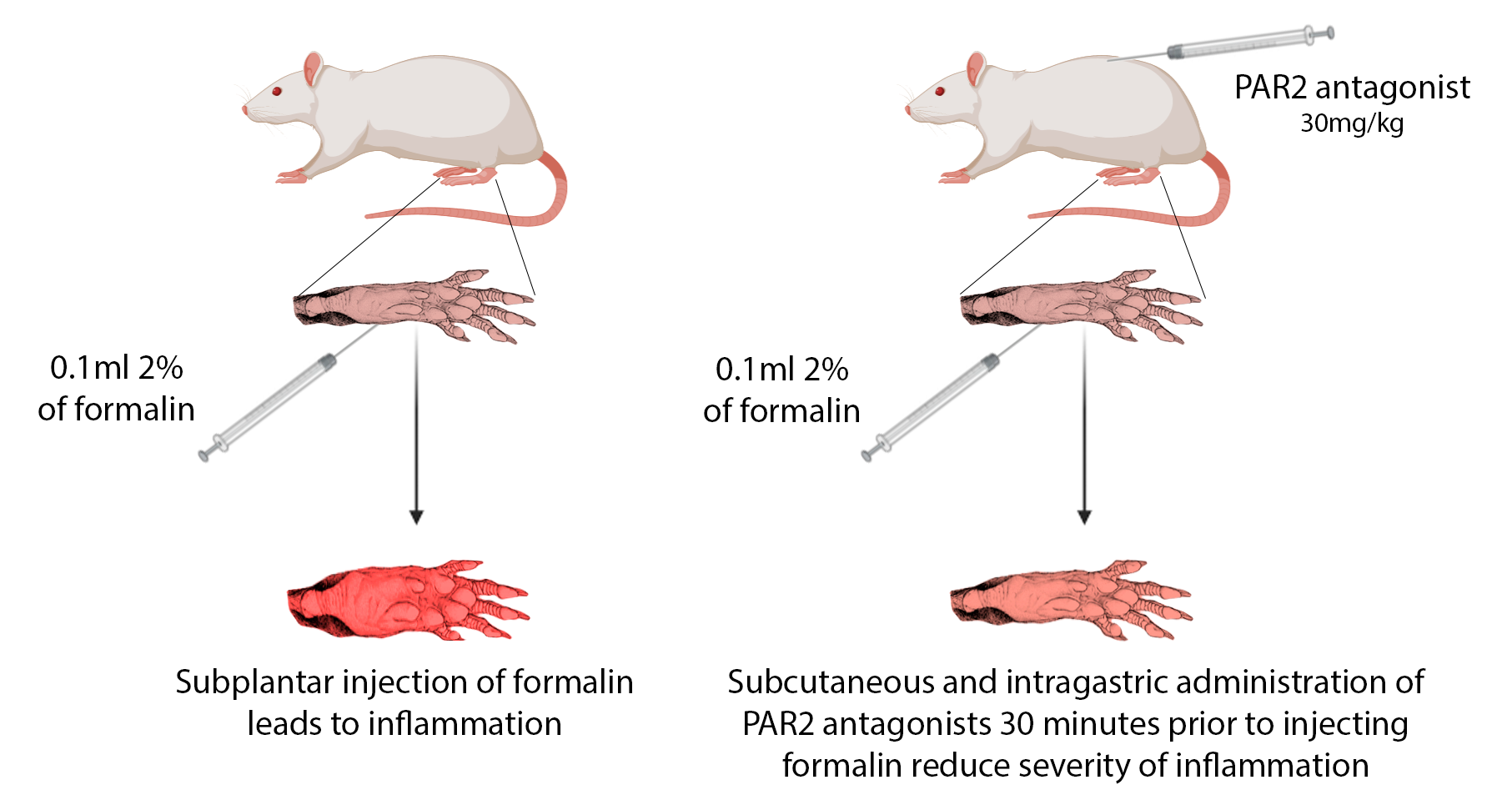Screening of anti-inflammatory activity of 4.5-dihydroisoxazol-5-carboxamide (PAR-2 inhibitors) based on formaldehyde oedema model among white lab rats
DOI:
https://doi.org/10.18413/rrpharmacology.9.10061Abstract
Introduction: Rheumatoid arthritis (RА) is an immune-inflammatory disease intrinsic to up to 1.0% of the world’s population. Standard drugs for RA therapy are basic medications, glucocorticoids and non-steroid anti-inflammatory drugs, which often only ease or hinder the course of disease, not curing the patient completely. Also, on the average 20-50 % of patients are unresponsive to treatment, allergic to the prescribed drugs or find them ineffective. That is why medications with a different mechanism of action are being widely researched, some of them being antagonists of proteinase-activated receptors (PAR-2).
Materials and Methods: The inflammatory process was reproduced by injecting a 2% solution of neutral formalin in a volume of 0.1 mL under the aponeurosis of the posterior left foot. A total of 84 white rats were used in the experiment. Diclofenac sodium was administered as a reference drug.
Results and Discussion: An experiment on researching the impact of 5 samples of derivatives of 4.5-dihydroisoxazol-5-carboxamide on formalin oedema development among rats showed that the compound R001, compared with other substances studied, differs in the late onset of the therapeutic effect when ingested; the restoration of the foot volume to the initial level occurs only after the introduction of R005, R004 and R002. R005 to a greater extent than other compounds prevents the development of edema and has greater therapeutic efficacy than diclofenac sodium both with intragastric administration and subcutaneous injection.
Conclusion: All five compounds in question showed anti-inflammatory activity, with the spectrum not so unequivocal both in qualitative and quantitative values.
Graphical Abstract

Keywords:
4.5-dihydroisoxazol-5-carboxamide derivatives, formaldehyde oedema, PAR-2 inhibitors, rheumatoid arthritisReferences
Abassi YA, Xi B, Zhang W, Ye P, Kirstein SL, Gaylord MR, Feinstein SC, Wang X, Xu X (2009) Kinetic cell-based morphological screening: prediction of mechanism of compound action and off-target effects. Chemistry & Biology16(7): 712–723 https://doi.org/10.1016/j.chembiol.2009.05.011 [PubMed][Full text]
Bao Y, Hou W, Hua B (2013) Protease-activated receptor 2 signalling pathways: a role in pain processing. Expert Opinion on Therapeutic Targets 18(1): 15–27 https://doi.org/10.1517/14728222.2014.844792 [PubMed]
Calabrò A, Caterino AL, Elefante E, Valentini V, Vitale A, Talarico R, Cantarini L, Frediani B (2016) One year in review 2016: Novelties in the treatment of rheumatoid arthritis. Clinical and Experimental Rheumatology 34(3): 357–372. [PubMed]
Cho NC, Seo SH, Kim D, Shin JS, Ju J, Seong J, Seo SH, Lee I, Lee KT, Kim YK, No KT, Pae AN (2016) Pharmacophore-based virtual screening, biological evaluation and binding mode analysis of a novel protease-activated receptor 2 antagonist. Journal of Computer-Aided Molecular Design 30(8): 625–637 https://doi.org/10.1007/s10822-016-9937-9 [PubMed]
Ding Q, Hu W, Wang R, Yang Q, Zhu M, Li M, Cai J, Rose P, Mao J, Zhu YZ (2023) Signaling pathways in rheumatoid arthritis: implications for targeted therapy. Signal Transduction and Target Therapy 8(1): 68 https://doi.org/10.1038/s41392-023-01331-9 [PubMed][PMC]
GBD 2021 Rheumatoid Arthritis Collaborators (2023) Global, regional, and national burden of rheumatoid arthritis, 1990–2020, and projections to 2050: a systematic analysis of the Global Burden of Disease Study 2021. The Lancet Rheumatology 5(10): e594–e610 https://doi.org/10.1016/s2665-9913(23)00211-4 [PubMed][PMC]
Glantz S (1998) Medical and Biological Statistics, Мoscow, Practica, 459 pp. [in Russian]
Kong HH, Khaziakhmetova VN, Ziganshina LE (2015) Modeling inflammatory edema: Are the models interchangeable. Experimental and Clinical Pharmacology 78(7): 24–31. [PubMed]
Mironov АN (2012) Guide onConducting Preclinical Trial of Medications. Part 1. Ministry of Health and Social Development of the Russian Federation, Nauchny Centr Expetizy Sredstv Meditsinskogo Primemeniya [Scientific Center for Expert Evaluation of Medicinal Products], Moscow. [in Rissian]
Prasad P, Verma S, Surbhi, Ganguly NK, Chaturvedi V, Mittal SA (2023) Rheumatoid arthritis: advances in treatment strategies. Molecular and Cellular Biochemistry 478(1): 69–88 https://doi.org/10.1007/s11010-022-04492-3 [PubMed]
Russo V, Falco L, Tessitore V, Mauriello A, Catapano D, Napolitano N, Tariq M, Caturano A, Ciccarelli G, D'Andrea A, Giordano A (2023) Anti-inflammatory and anticancer effects of anticoagulant therapy in patients with malignancy. Life 13(9): 1888. https://doi.org/10.3390/life13091888 [PubMed][PMC]
Scherer HU, Haupl T, Burmester GR (2020) The etiology of rheumatoid arthritis. Journal of Autoimmunity 110: 102400. https://doi.org/10.1016/j.jaut.2019.102400 [PubMed]
Published
How to Cite
Issue
Section
License
Copyright (c) 2023 Михаил К. Корсаков, Владимир Н. Федоров, Николай А. Смирнов, Антон А. Шетнев, Ольга В. Леонова, Никита Н. Вольхин, Александр И. Андреев

This work is licensed under a Creative Commons Attribution 4.0 International License.
 Русский
Русский
 English
English

